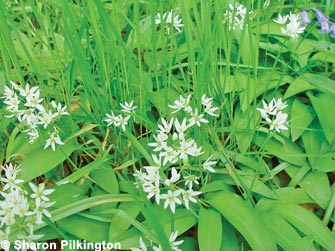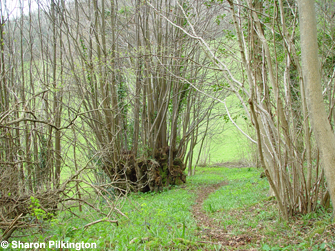
Special Mendip habitats
Introduction | Limestone cliffs, crags, caves and screes | Limestone heath | Old lead workings | Ash-lime woodland
Ash-lime woodland

Extensive ancient ash woodland habitats such as those at Asham Wood and Rodney Stoke are characteristic of older Mendip limestone woods developed over coarse scree, cliffs, steep rocky slopes and ravines. Small-leaved lime is a formerly widespread tree that is now mainly confined to very old woodlands, and it is a characteristic canopy tree in these woods, where it has frequently been coppiced like hazel. In the ravine woods of Ebbor Gorge, wych elm replaces the lime, but the woodland is equally diverse. Past management of these woodlands has been by traditional coppice-with-standards methods, and this has favoured the development of a well-developed shrub understorey and a very diverse ground flora. Hazel coppice stools are usually prominent, and other shrubs typically include holly, dogwood, spindle, wayfaring-tree and guelder rose.

The principal woodland herb species vary according to soil type, aspect and drainage, but drier soils are commonly covered by extensive carpets of dog's-mercury and wood anemone. Wetter base-rich ground is often dominated by ramsons, which smell strongly of garlic when in leaf. More locally, there are species that are normally restricted to ancient woodlands (considered to have been continuously wooded for at least 400 years). These include pignut, lily-of-the-valley, and yellow archangel.
The generally sheltered and humid conditions within these woodlands provide ideal habitat for many different species of lower plant, lichen and fungi, and many sites also support the rare and elusive common dormouse.
- Home
- Overview maps
- Locality
areas
- Cheddar Gorge
- Charterhouse
- Blackdown
- Burrington Combe
- Shipham & Rowberrow
- Crook Peak & Axbridge
- Banwell to Churchill
- Priddy
- Harptree & Smitham Hill
- Draycott & Westbury-sub-Mendip
- Wookey Hole & Ebbor Gorge
- Wells
- Great Elm & Vallis Vale
- Mells & the Wadbury Valley
- The Vobster area
- The Whatley area
- Torr Works & Asham Wood
- Beacon Hill
- Stoke St Michael & Oakhill
- Holwell & Nunney
- Shepton Mallet & Maesbury
- Gurney Slade & Emborough
- The Nettlebridge valley
- Geology
- Minerals and mines
- Quarrying
- Caves and karst
- Biodiversity
- Detailed site information
- Acknowledgements
- External links
- Search
- Site map